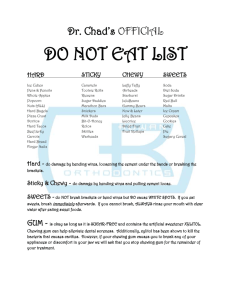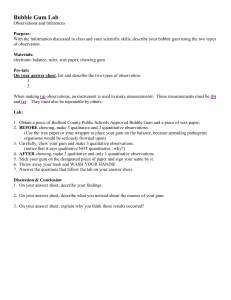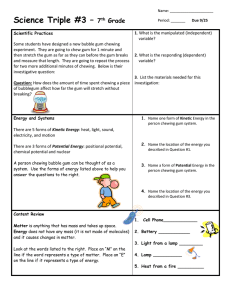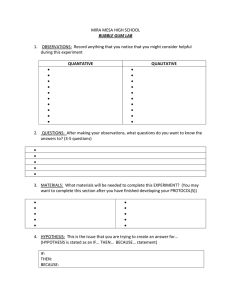Bubble Gum Scientific Method Lab Name Period _____ Date
advertisement
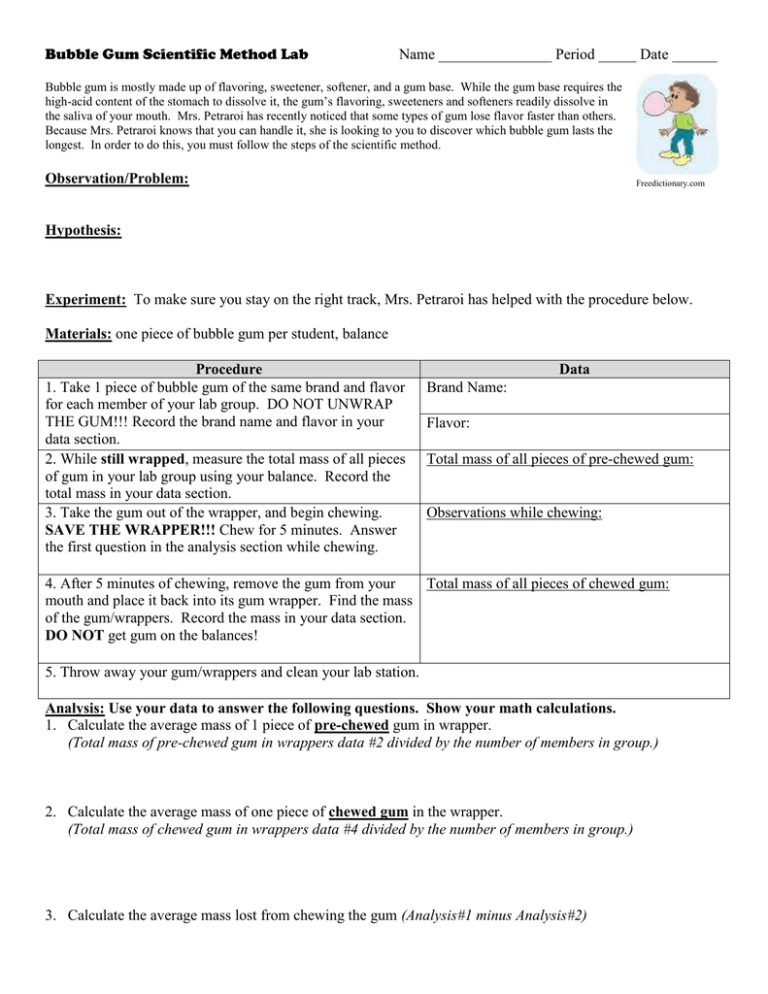
Bubble Gum Scientific Method Lab Name _______________ Period _____ Date ______ Bubble gum is mostly made up of flavoring, sweetener, softener, and a gum base. While the gum base requires the high-acid content of the stomach to dissolve it, the gum’s flavoring, sweeteners and softeners readily dissolve in the saliva of your mouth. Mrs. Petraroi has recently noticed that some types of gum lose flavor faster than others. Because Mrs. Petraroi knows that you can handle it, she is looking to you to discover which bubble gum lasts the longest. In order to do this, you must follow the steps of the scientific method. Observation/Problem: Freedictionary.com Hypothesis: Experiment: To make sure you stay on the right track, Mrs. Petraroi has helped with the procedure below. Materials: one piece of bubble gum per student, balance Procedure 1. Take 1 piece of bubble gum of the same brand and flavor for each member of your lab group. DO NOT UNWRAP THE GUM!!! Record the brand name and flavor in your data section. 2. While still wrapped, measure the total mass of all pieces of gum in your lab group using your balance. Record the total mass in your data section. 3. Take the gum out of the wrapper, and begin chewing. SAVE THE WRAPPER!!! Chew for 5 minutes. Answer the first question in the analysis section while chewing. Data Brand Name: Flavor: Total mass of all pieces of pre-chewed gum: Observations while chewing: 4. After 5 minutes of chewing, remove the gum from your Total mass of all pieces of chewed gum: mouth and place it back into its gum wrapper. Find the mass of the gum/wrappers. Record the mass in your data section. DO NOT get gum on the balances! 5. Throw away your gum/wrappers and clean your lab station. Analysis: Use your data to answer the following questions. Show your math calculations. 1. Calculate the average mass of 1 piece of pre-chewed gum in wrapper. (Total mass of pre-chewed gum in wrappers data #2 divided by the number of members in group.) 2. Calculate the average mass of one piece of chewed gum in the wrapper. (Total mass of chewed gum in wrappers data #4 divided by the number of members in group.) 3. Calculate the average mass lost from chewing the gum (Analysis#1 minus Analysis#2) 4. Calculate the percent lost (Analysis #3 divided by analysis#1 and multiply by 100). RECORD ON THE CLASS GRAPH! 5. Graph the percent lost from EACH type of gum in the space below. Conclusion: Based on the graph above, which gum lost the highest percentage of mass due to the digestive process in your mouth? What ingredients were lost while chewing? Based on the evidence, would you accept or reject your hypothesis? What are two possible sources of error in this lab? What would you do differently, if you did this lab again? Explain.



